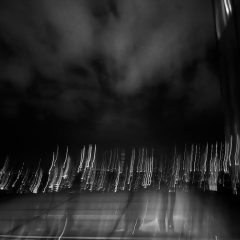Eraserhead (1977) is David Lynch’s debut feature film. Eraserhead follows a naive young man called Henry, who lives in an industrial and noisy world. Henry accidentally gets his girlfriend, Mary X, pregnant and Mary gives birth to a mutated baby. After living with Henry and the baby, Mary can’t take it anymore and leaves Henry to take care of the child. Following this we see Henry deal with the concepts of sex, fatherhood, adulthood, and mental health. The themes of sex and children are also seen in The Alphabet, which was created 8 years before Eraserhead was released.
The overall sound of Eraserhead is industrial, noisy, and claustrophobic. The sound design of Eraserhead was created by David Lynch and Alan Splet. Splet and Lynch sat down and listened through stock sound effects, however they decided to record the sound from scratch.
In an interview, Lynch says “picture dictates sound,” but he also says that it can be the other way round and that “sounds will conjure an image.” These two quotes are very true to Eraserhead, as the sound design helps the viewer feel more immersed in the film.
Eraserhead had a very low budget of $10,000. Eraserhead started as a student film when Lynch was studying at AFI in Los Angeles. Soon, the budget had run out and Lynch had to gather money in other ways. This happened multiple times, and every time the budget ran out, production would halt until they could afford to start again. Because of this, Lynch and Splet had a very small amount of money to use, so they had a D.I.Y. mindset while creating the sound.
I found Eraserhead’s sound design to be very inspirational to me while working on The Alphabet. Both the final product and the process of how Lynch and Splet created the sound was interesting and helpful to me because they had to use what was available to them to create the sound. I took inspiration from this process by using LCC’s foley and composition room to record vocals and foley and to mix the audio. I also used sounds from around me in my flat by recording my sink, boiler, and gas pipes with contact microphones and hydrophones.
One recurring sound throughout Eraserhead is the sound of wind, as heard in this scene (1:58 – 2:11). The wind in this movie was recorded by Splet in a village in Scotland called Findhorn. I found the use of taking wind, a normal everyday sound and making it disturbing and overbearing. In The Alphabet, I used the wind to use as the sound of a moving object. Instead of recording natural wind, I thought of creating this sound from another source. I used the Moog Mother 32 which is a semi analog synthesiser. The synthesiser has a noise function which creates a windlike noise. The reason I used the Mother 32 instead of real wind was that I could match the wind to the picture better then if I was to do it practically with real wind foley.
